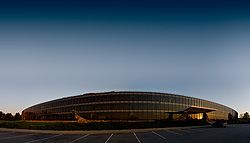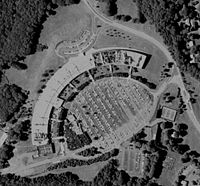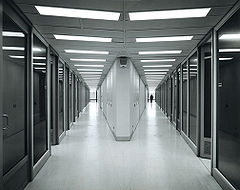
Thomas J. Watson Research Center
Encyclopedia

IBM
International Business Machines Corporation or IBM is an American multinational technology and consulting corporation headquartered in Armonk, New York, United States. IBM manufactures and sells computer hardware and software, and it offers infrastructure, hosting and consulting services in areas...
Research Division.
The center is on three sites, with the main laboratory in Yorktown Heights, New York
Yorktown Heights, New York
Yorktown Heights is a census-designated place in the town of Yorktown in Westchester County, New York, United States. The population was 1,781 at the 2010 census.-Geography:Yorktown Heights is located at ....
, 38 miles north of New York City, a building in Hawthorne, New York
Hawthorne, New York
Hawthorne is an unincorporated hamlet and census-designated place located in the town of Mount Pleasant in Westchester County, New York. The population was 4,586 at the 2010 census.-History:...
, and offices in Cambridge, Massachusetts
Cambridge, Massachusetts
Cambridge is a city in Middlesex County, Massachusetts, United States, in the Greater Boston area. It was named in honor of the University of Cambridge in England, an important center of the Puritan theology embraced by the town's founders. Cambridge is home to two of the world's most prominent...
.
Overview
The research center is named for both Thomas J. Watson SrThomas J. Watson
Thomas John Watson, Sr. was president of International Business Machines , who oversaw that company's growth into an international force from 1914 to 1956...
and Thomas Watson, Jr., who led IBM as president and CEO respectively from 1915 (when it was known as CTR
Computing Tabulating Recording Corporation (CTR)
The Computing Tabulating Recording Corporation was incorporated on June 16, 1911 in Endicott, New York a few miles west of Binghamton. CTR was formed through a merger of four separate corporations: Tabulating Machine Company , the Computing Scale Corporation , the International Time Recording...
) to 1971.

Hardware
Hardware is a general term for equipment such as keys, locks, hinges, latches, handles, wire, chains, plumbing supplies, tools, utensils, cutlery and machine parts. Household hardware is typically sold in hardware stores....
(physical sciences and semiconductors research), services (business modelling, consulting, and operations research), software (programming languages, security, speech recognition, data management, and collaboration tools), and systems (operating systems and server design), as well as to extend the mathematics and science that support the information technology industry.
The center was founded at Columbia University
Columbia University
Columbia University in the City of New York is a private, Ivy League university in Manhattan, New York City. Columbia is the oldest institution of higher learning in the state of New York, the fifth oldest in the United States, and one of the country's nine Colonial Colleges founded before the...
in 1945 as the Watson Scientific Computing Laboratory, on 116th Street in New York, expanding to 115th Street in 1953. More labs were later opened in Westchester County, New York
Westchester County, New York
Westchester County is a county located in the U.S. state of New York. Westchester covers an area of and has a population of 949,113 according to the 2010 Census, residing in 45 municipalities...
beginning in the late 1950s with the temporary facility and research headquarters at the former Robert S. Lamb estate in Croton-on-Hudson, New York
Croton-on-Hudson, New York
Croton-on-Hudson is a village in Westchester County, New York, United States. The population was 8,070 at the 2010 census. It is located in the town of Cortlandt, in New York City's northern suburbs...
, with others in Yorktown Heights, and downtown Ossining. The new headquarters were finally located with a new lab in Yorktown Heights designed by architect Eero Saarinen
Eero Saarinen
Eero Saarinen was a Finnish American architect and industrial designer of the 20th century famous for varying his style according to the demands of the project: simple, sweeping, arching structural curves or machine-like rationalism.-Biography:Eero Saarinen shared the same birthday as his father,...
completed in 1961, with the 115th Street site closing in 1970. IBM later donated the New York City buildings to Columbia University; they are now known as the Casa Hispanica and Watson Hall. The lab expanded to Hawthorne in 1984.
Notable staff has included the mathematicians Benoît Mandelbrot
Benoît Mandelbrot
Benoît B. Mandelbrot was a French American mathematician. Born in Poland, he moved to France with his family when he was a child...
, Ralph E. Gomory
Ralph E. Gomory
Ralph Edward Gomory is an American applied mathematician and executive. Gomory worked at IBM as a researcher and later as an executive. During that time, his research led to the creation of new areas of applied mathematics....
, Shmuel Winograd
Shmuel Winograd
Shmuel Winograd is an American computer scientist, noted for his contributions to computational complexity. He has proved several major results regarding the computational aspects of arithmetic; his contributions include the Coppersmith-Winograd algorithm and an algorithm for Fast Fourier...
, Alan Hoffman
Alan Hoffman (mathematician)
Alan Jerome Hoffman, born May 30, 1924 in New York City, is a mathematician and IBM fellow emeritus, T. J. Watson Research Center, IBM, Yorktown Heights, N.Y. He is the founding editor of the Journal Linear Algebra and its Applications, and holds several patents...
, Don Coppersmith
Don Coppersmith
Don Coppersmith is a cryptographer and mathematician. He was involved in the design of the Data Encryption Standard block cipher at IBM, particularly the design of the S-boxes, strengthening them against differential cryptanalysis...
, Mike Shub, Gregory Chaitin
Gregory Chaitin
Gregory John Chaitin is an Argentine-American mathematician and computer scientist.-Mathematics and computer science:Beginning in 2009 Chaitin has worked on metabiology, a field parallel to biology dealing with the random evolution of artificial software instead of natural software .Beginning in...
, the inventor Robert Dennard
Robert Dennard
Robert Dennard is an American electrical engineer and inventor.Dennard was born in Terrell, Texas, U.S.. He received his B.S. and M.S. degrees in Electrical Engineering from Southern Methodist University, Dallas, in 1954 and 1956, respectively. He earned a Ph.D. from Carnegie Institute of...
, roboticist Matthew T. Mason
Matthew T. Mason
Matthew T. Mason is an American roboticist and the Director of the Robotics Institute at Carnegie Mellon University...
, author Clifford A. Pickover
Clifford A. Pickover
Clifford A. Pickover is an American author, editor, and columnist in the fields of science, mathematics, and science fiction, and is employed at the IBM Thomas J. Watson Research Center in Yorktown, New York.- Biography :He received his Ph.D...
, computer scientists Frances E. Allen
Frances E. Allen
Frances Elizabeth "Fran" Allen is an American computer scientist and pioneer in the field of optimizing compilers. Her achievements include seminal work in compilers, code optimization, and parallelization...
, John Cocke
John Cocke
John Cocke was an American computer scientist recognized for his large contribution to computer architecture and optimizing compiler design. He is considered by many to be "the father of RISC architecture."...
, Stuart Feldman
Stuart Feldman
Stuart Feldman received an A.B. in astrophysical sciences from Princeton University and a Ph.D in applied mathematics from the Massachusetts Institute of Technology. He is best known as the creator of the computer software program make for UNIX systems...
, Ken Iverson
Kenneth E. Iverson
Kenneth Eugene Iverson was a Canadian computer scientist noted for the development of the APL programming language in 1962. He was honored with the Turing Award in 1979 for his contributions to mathematical notation and programming language theory...
, Irene Greif and Mark N. Wegman, Barry Appelman
Barry Appelman
Barry Appelman is recognized as being the father of the "buddy list" and AOL instant messenger. Companies had been using crude forms of Instant messaging within their own networks for over forty years, but the idea of presence, i.e. who is logged on at any given time, was non existent...
, the inventor of AOL Instant Messenger
AOL Instant Messenger
AOL Instant Messenger is an instant messaging and presence computer program which uses the proprietary OSCAR instant messaging protocol and the TOC protocol to allow registered users to communicate in real time. It was released by AOL in May 1997...
, Postfix
Postfix
Postfix may refer to:* Suffix * Postfix notation, a way of writing algebraic and other expressions. Also known as reverse Polish notation* Postfix , a mail transfer agent program...
and TCP Wrapper
TCP Wrapper
TCP Wrapper is a host-based networking ACL system, used to filter network access to Internet Protocol servers on operating systems such as Linux or BSD...
author, Wietse Zweitze Venema, the 1990 Economics Nobel Prize winner, Harry Markowitz
Harry Markowitz
Harry Max Markowitz is an American economist and a recipient of the John von Neumann Theory Prize and the Nobel Memorial Prize in Economic Sciences....
, and physicists Llewellyn Thomas
Llewellyn Thomas
Llewellyn Hilleth Thomas was a British physicist and applied mathematician. He is best known for his contributions to atomic physics, in particular:...
, Rolf Landauer
Rolf Landauer
Rolf William Landauer was an IBM physicist who in 1961 argued that when information is lost in an irreversible circuit, the information becomes entropy and an associated amount of energy is dissipated as heat...
, Charles H. Bennett, J. B. Gunn, 1973 Physics Nobel Prize winner, Leo Esaki
Leo Esaki
Reona Esaki also known as Leo Esaki is a Japanese physicist who shared the Nobel Prize in Physics in 1973 with Ivar Giaever and Brian David Josephson for his discovery of the phenomenon of electron tunneling. He is known for his invention of the Esaki diode, which exploited that phenomenon...
, and Solomon Assefa Research Scientist.
The work done at the Center from 1960 - 1984 was named an IEEE Milestone in 2009.
Supercomputers
As of November 2010, the center houses three TOP500TOP500
The TOP500 project ranks and details the 500 most powerful known computer systems in the world. The project was started in 1993 and publishes an updated list of the supercomputers twice a year...
supercomputers; the oldest and still fastest of whom, a BlueGene/L system designed for protein folding
Protein folding
Protein folding is the process by which a protein structure assumes its functional shape or conformation. It is the physical process by which a polypeptide folds into its characteristic and functional three-dimensional structure from random coil....
simulations, called BGW (Blue Gene Watson), entered the list in the 06/2005 issue, then positioned second behind fellow Blue Gene/L in LLNL
Lawrence Livermore National Laboratory
The Lawrence Livermore National Laboratory , just outside Livermore, California, is a Federally Funded Research and Development Center founded by the University of California in 1952...
.
Another well-known installation is Watson
Watson (artificial intelligence software)
Watson is an artificial intelligence computer system capable of answering questions posed in natural language, developed in IBM's DeepQA project by a research team led by principal investigator David Ferrucci. Watson was named after IBM's first president, Thomas J...
, an artificial intelligence
Artificial intelligence
Artificial intelligence is the intelligence of machines and the branch of computer science that aims to create it. AI textbooks define the field as "the study and design of intelligent agents" where an intelligent agent is a system that perceives its environment and takes actions that maximize its...
system capable of answering natural language
Natural language
In the philosophy of language, a natural language is any language which arises in an unpremeditated fashion as the result of the innate facility for language possessed by the human intellect. A natural language is typically used for communication, and may be spoken, signed, or written...
questions, which won several Jeopardy!
Jeopardy!
Griffin's first conception of the game used a board comprising ten categories with ten clues each, but after finding that this board could not be shown on camera easily, he reduced it to two rounds of thirty clues each, with five clues in each of six categories...
games against human contestants in February 2011 on the site.
Buildings

The Yorktown Heights building, situated on private land not generally accessible to the public, is a large crescent-shaped structure consisting of three levels by 40 aisles. The lowest level is partially underground in some areas toward the shorter side of the crescent, which also leads to the employee parking lots. A large overhang protrudes from the front entryway of the building, and faces the visitor parking lot (See Map of Yorktown Heights Center in the External Links section). The building houses a library, an auditorium and a cafeteria.
Hawthorne
The Hawthorne building is a leased facility located on Skyline Drive, which is part of an industrial park shared by several area businesses. (As with all IBM Research facilities, secured access is still required for the building.) The Hawthorne building (located at 19 Skyline Drive) is easily recognizable by its mirrored facade and large blue pole. Located approximately 25 miles north of New York City, the Hawthorne site is smaller than its sister site at Yorktown Heights (with none of the wet lab space found in the Yorktown Heights facility). The primary focus at Hawthorne is software- and services-related research, whereas Yorktown Heights focuses on chemistry, mathematics, physics, silicon technology, and electrical engineering research, as well as some software and services. The building also contains a cafeteria, presentation center and library. The site, opened in 1984, was designed by Michael Harris Spector.
Cambridge
The Cambridge facility can be found at 1 Rogers Street, Cambridge, MA; it is located in one of IBM's Lotus Software
Lotus Software
Lotus Software is a software company with headquarters in Westford, Massachusetts...
development locations. Research at Cambridge comprises the Collaborative User Experience Group and the XML Standards/Technology Team.
Further reading
500+ pages, including several chapters on IBM's Watson Scientific Computing Laboratory at Columbia University in the 1940s and 50s. Also available in PDF.External links
- Wallace J. Eckert Founder and Director of the Watson Scientific Computing Laboratory at Columbia University
- IBM Watson Laboratory at Columbia University
- The Thomas J. Watson Astronomical Computing Bureau (1937)
- Watson Lab Gallery
- Thomas J. Watson Research Center
- Map of Yorktown Heights Center
- IBM Research Division

